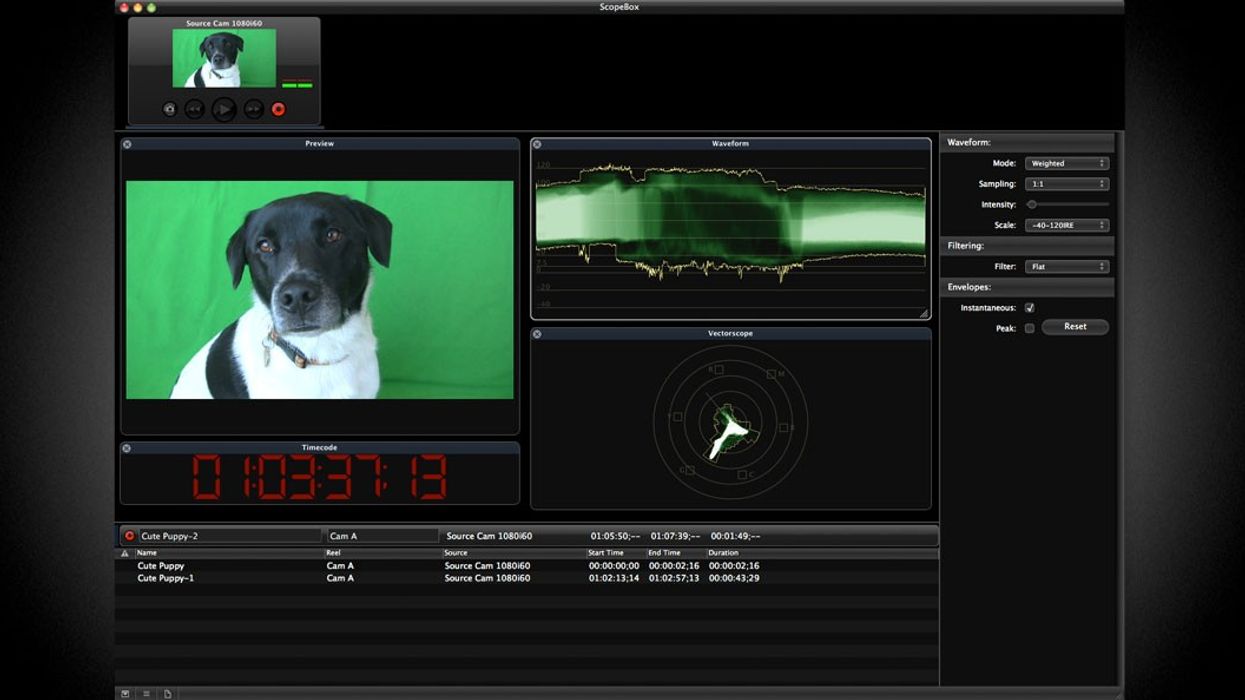Scopebox 3.0 On-Set Monitoring and Recording Software Drops from $700 to $99

When Divergent Media's Scopebox was released a few years ago, it was a $700 piece of software that was fairly unique at the time: a way to turn any Mac laptop into, well... a box of scopes. Waveforms, vectorscopes, and RGB parades were handy on-set aides, and though similar to Adobe OnLocation (now bundled as part of Premiere Pro), the fact that the forthcoming version 3.0 of the software will drop the price from $700 to $99 makes it a new ball game.
Here's a presentation on Scopebox from cameradepartment.tv's coverage of NAB:
Version 3.0 of the software should be out later this year.
My question is, can you use Scopebox as a post-production monitoring solution?
Apparently the only way to take advantage of Scopebox's waveform/vectorscope options during post-production is to utilize a second computer's video hardware. Scopebox is designed as an on-set monitoring and recording aide, as opposed to, say, Synthetic Aperture's Test Gear, which is a set of similar monitoring options for After Effects. Why the need for such scopes in post? While Final Cut Pro and Premiere Pro ship with their own parade of test scopes, After Effects does not. It makes using a color correction plug-in like Colorista far less scientific, and I've always wondering why AE doesn't include the native monitoring palettes that Premiere Pro does. Perhaps that's another area that Red Giant could pursue with their Magic Bullet suite...
So here's my question for you -- if you do color correction in After Effects, what do you use for monitoring (other than the subjective preview window)?
Link: Scopebox 3.0 Preview Sign-Up
Press Release
New in ScopeBox 3.0:
Adaptive Kernel Engine
ScopeBox 3.0 introduces a brand new video processing pipeline called the Adaptive Kernel Engine (AKE). AKE allows ScopeBox to customize the processing load to optimally match the current computer, video source, bit depth, and palette roster. AKE is optimized for both Intel and PowerPC, and allows ScopeBox 3.0 to extract even more performance from your existing system. AKE enables tools like alerts, envelopes, and synthesized composite waveforms, which were previously unobtainable in software only solutions.
Fail-Safe Capture and Live Edit
The new fail-safe capture functionality of ScopeBox 3.0 provides unparalleled peace of mind. With traditional direct-to-disk tools, problems during capture can result in corrupt QuickTime files requiring costly recovery services. Fail-safe capture constantly flushes coherent QuickTime data to disk so that no matter when or how the record is stopped, you can be confident you’ll end up with a valid, playable file.
In addition, live edit can be enabled on most fail-safe captures, allowing the QuickTime movie to be imported into your favorite edit system and cut while still being recorded. You can be editing before the director calls “cut!”
Envelopes and Alerts
Envelopes and alerts combine to allow the operator to better keep an eye on their signal while juggling multiple sources and tests. With envelopes, each palette maintains a visual record of peak values allowing a quick visual glance to check the status of a palette. Alerts generate timecode annotated notes when threshold values are detected in your video, audio, or timecode signal. These alerts can be exported as lists or edit ready markers for later review.
Price and Availability
Current customers of ScopeBox can register now for the free beta of ScopeBox 3.0. The beta program will begin April 18th, with users being added in stages over the following days. Current users of ScopeBox 2.0 will receive a free upgrade to 3.0. In the interim, the price of ScopeBox 2.0 will be lowered to match the upcoming $99.99 price point.












